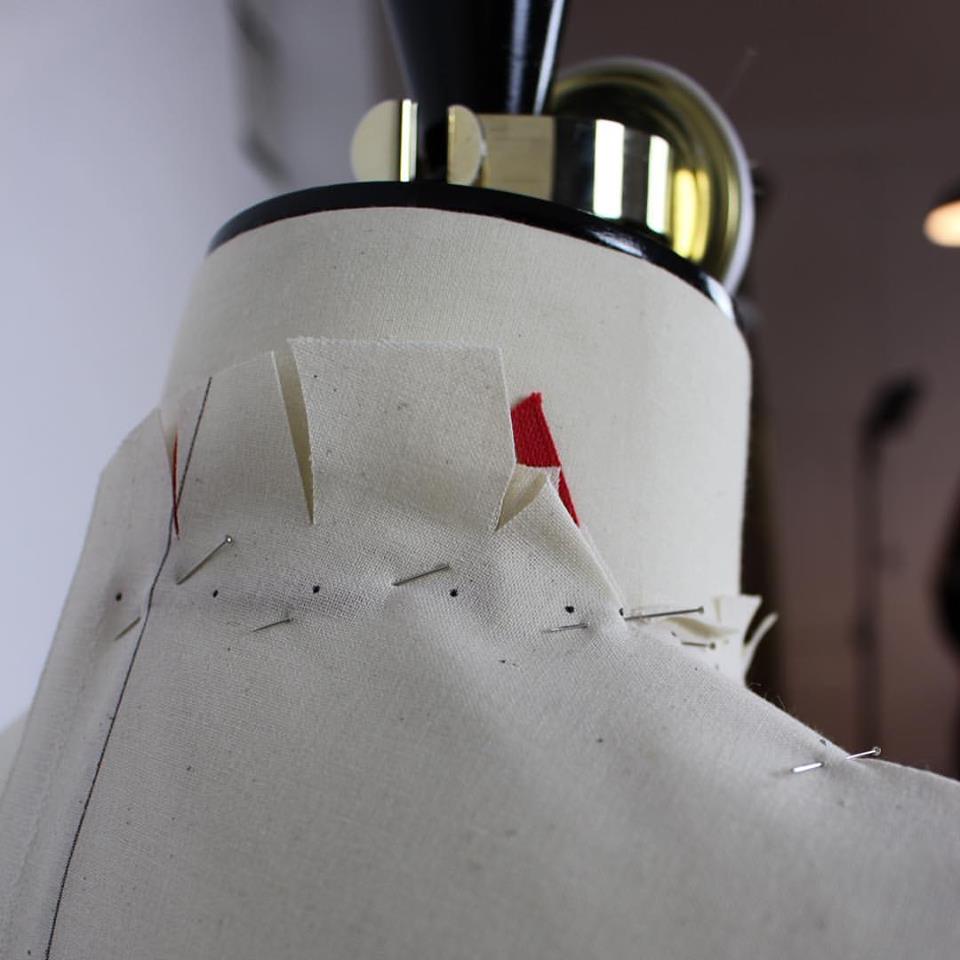Haute Couture Draping

1. What is Haute Couture Draping?
Draping, or moulage in French, is a couture technique that originally comes from Paris haute couture maisons.
It consist of draping the white toile (muslin) directly on the dress form. You can instantly see how your idea will look in volume, and you can easily try new forms.
Moulage is done only on the right side of the form if the garment is symmetrical.
- Why use draping?
When you drape the fabric on form, you can instantly see the garment in volume. You can easily change or make alterations: to move the darts, to create more or less ease, to cut your armsye or hemline….the possibilities are endless. Moulage is pleasant and intuitive process. That’s why all the fashion designers and patternmakers simply LOVE draping.
3. Which brands use draping?
Draping is used:
- By haute couture and bespoke tailoring brands, to create unique dress for a particular client.
- In luxury pret-à-porter in order to create prototypes. The atelier transform the designer’s sketch into the 3D garments, to see how a garment will look on the body («bien-aller» in French) before creating it in a final fabric.
- Creative process : designer use moulage to look for the new forms and ideas.
So basically most of the haute couture and pret-à-porter brands are using draping at one stage or another of their work.
4. What fabric is used in draping?
The moulage is done in white toile/muslin, before a paper pattern and then the garment in final fabric.
The fabric used for draping should be of similar weight and thickness that your final fabric.
5. Can I drape directly in final fabric?
Yes, you can of course drape in the final fabric, but we strongly recommend you to use white muslin because you can easily write on it with a pencil as recommended by our professor Aurélie, and make alterations, and because it’s inexpensive, so less stress in case of error!
6. What else will I need to do draping*?
Dress form (if you create a jacket, you will need an arm for your form).
Thin steel pins with no head on them (important), good scissors, draping tape (Paris Maisons de couture use red or black ones), a «japanese» red ruler, thin transparent 30 cm ruler with red marks, curves, iron and large table to spread the fabric.
* ModaHow will soon release the Haute Couture Draping Kit with supplies used in Paris ateliers: french steel pins, toile, red draping tape, etc…: watch for updates!
7. How my haute couture draping skills can help me to find a job in fashion?
Good draping skills are very valuable. All luxury ready-to-wear companies are looking for skilled people who know draping. If you learn all the basics of draping and practice a lot, you will be a precious employee.
8. Why French Haute Couture draping is so famous?
Paris is famous for its legendary historical brands and Fashion weeks: celebrities, star bloggers, etc. But behind all this hype is what really makes French fashion industry different: its savoir-faire. Speaking about french savoir-faire, media usually use the word «artisans», but it’s generally about all experienced people working in French fashion industry, all the knowledge and techniques accumulated during long years.
9. What is particular about the French haute couture techniques?
French moulage is very accurate and precise. It’s real fashion mathematics! You should know how to count! There is a certain logic into the whole process, whether you put the draping tape on the dress form (very important step), drape the fabric on the form, create darts or check your measurements on the table. You will need patience and you should take your time.
It’s all about details, which are very important. If the professor tells you to put a little mark, it should really be a point, and not a little line. If you’re asked to create a dart using all the fabric left, you will use all the fabric. And when you create an ease, it should be the same inside all parts of the body, except the shoulders…etc.
All these details can seem very little, but finally they make big difference and your dress really look well-fitted and well done, which is what luxury is about.
10. I studied draping in my University/School, so I already know it very well.
Good for you! But even if you already studied draping, we suggest you continue to learn and to practice, especially if you haven’t draped for a long time. In fact, like all the « hand skills », if you don’t practice you can loose it easily.
Also, there are different countries and different approaches to draping. French Haute Couture Draping comes from the very heart of Paris ateliers, it’s very precise and it helps to create the most beautiful clothes in the world.